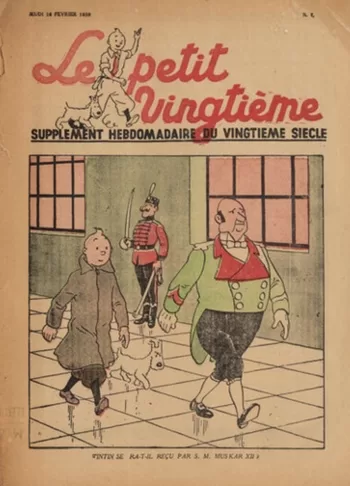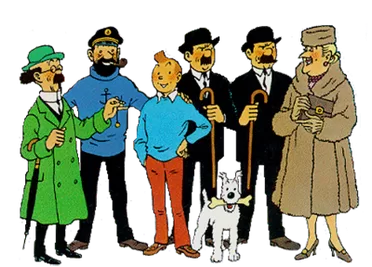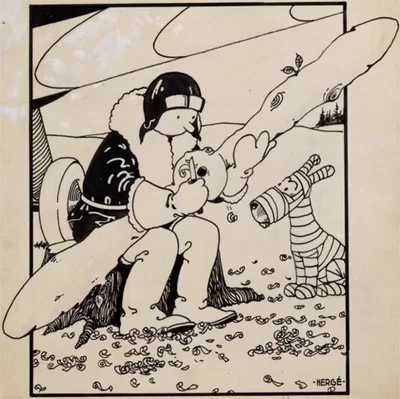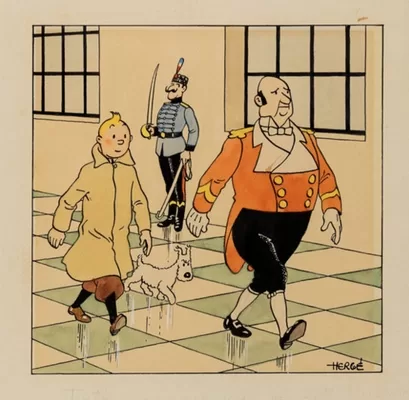Hergé and the Timeless Adventures of Tintin
In the vibrant world of 20th-century comics, few characters have had as significant an influence as Tintin, the intrepid young reporter created by Belgian artist Hergé, whose real name was Georges Rémi. First appearing in the early 1930s, Tintin has since become a cultural icon, captivating readers across generations with his adventures around the globe.
The genesis of this beloved character can be traced back to Hergé’s work in Le Petit Vingtième, a weekly children’s supplement of the Belgian newspaper Le Vingtième Siècle, where Tintin made his debut.

The Birth of Tintin
Hergé’s journey as a storyteller began in 1929 when he was tasked with creating a comic strip for Le Petit Vingtième.
Inspired by his fascination with journalism, travel, and adventure stories, Hergé introduced readers to Tintin in the tale titled “Tintin in the Land of the Soviets,” published in 1930.
This story marked the beginning of an extraordinary saga that would span over 24 volumes, each chronicling Tintin’s escapades alongside his loyal dog, Snowy, and a colorful cast of supporting characters, including the bumbling detective duo Thomson and Thompson and the irascible Captain Haddock.
Hergé’s art style was groundbreaking for its time, characterized by clean lines and meticulous attention to detail, which allowed him to create vibrant, immersive worlds that drew readers in.


The early covers of Tintin’s adventures, particularly those published in the 1930s, reflect a distinct artistic evolution and serve as a testament to Hergé’s innovative approach to storytelling.
The main characters of The Adventures of Tintin from left to right: Professor Calculus, Captain Haddock, Tintin, Thompson, Snowy (dog), Thomson and Bianca Castafiore
The Iconic Covers of the 1930s
The 1930s were pivotal for both Hergé and Tintin, with the character becoming increasingly popular. Each cover of Le Petit Vingtième from this decade showcased Hergé’s evolving style and his burgeoning mastery of visual narrative.


The covers often depicted Tintin in dynamic poses, engaging in thrilling adventures that hinted at the stories within.
One notable cover was for “Tintin and the Land of the Soviets” (1930), which illustrated Tintin’s encounters with various Soviet figures. The original artwork sold for $1,125,000 in 2019.
This bold depiction, laden with political undertones, exemplified Hergé’s ability to weave social commentary into his work, making Tintin not just a simple comic character but a representation of the times he lived in.
Another memorable cover was for “Tintin in the Congo” (1931), which featured a colorful depiction of Tintin against a vibrant jungle backdrop, foreshadowing the action and excitement readers would encounter in the storyline.
The cover not only captured the spirit of adventure but also reflected the artistic influences of the time, merging art deco aesthetics with Hergé’s unique flair.
Tintin art at auction
As part of our exploration of Hergé and the enduring legacy of Tintin, it is worth noting a significant piece of art that recently captured the attention of collectors and fans alike.


Heritage Auctions sold this remarkable original cover from the 1930s issues of Le Petit Vingtième—the iconic “Le Sceptre d’Ottokar,” published on February 16, 1939, just months before the outbreak of World War II for $137,500.00
This unique cover, originally drawn in ink and colored by Hergé in the same year, is one of only five covers rendered by the artist using direct colors and ink.
The term “museum-quality” is often overused, but in this case, it truly fits. This piece is not merely an illustration; it is a historic artifact of immense cultural significance.
The cover features Tintin, accompanied by his loyal dog Snowy, being escorted by a majordomo from the royal palace of Syldavia, the fictional kingdom where the story unfolds.
“King Ottokar’s Sceptre,” the eighth story in Hergé’s series, was initially serialized in black and white from August 4, 1938, to August 10, 1939, in Le Petit Vingtième, and would later see its color version released by Casterman in 1947.


This original artwork by Hergé comes with a certificate of authentication from the Works of Hergé, ensuring its provenance and authenticity. Measuring 8.25″ x 8.25″, this ink piece enhanced with watercolor and white gouache is framed and matted, showcasing Hergé’s masterful technique. With a signature that marks its value, this piece is in very good condition, making it a unique treasure in the world of comic art.
The first cover of Tintin’s adventures, “Tintin in the Land of the Soviets,” sold for a staggering $1,125,000 at Heritage Auctions in June 2019, setting a precedent for the value of Hergé’s original art.
The significance of such pieces cannot be overstated. The auction of “Le Sceptre d’Ottokar” captured the attention of collectors and Tintin enthusiasts, with bidding taking the artwork to $137,500.00, marking yet another milestone in the history of one of the world’s greatest masters of the Ninth Art.
Advertisement:
Cultural Impact and Legacy of Tintin
As the years went by, Hergé’s creations transcended the pages of Le Petit Vingtième, evolving into a series of graphic novels that captured the hearts of millions worldwide. Tintin’s adventures took readers to exotic locations such as Egypt, the Americas, and the fictional nation of Syldavia, all while tackling themes of friendship, justice, and the pursuit of truth.
Hergé’s work has inspired countless adaptations, from animated series and films to stage productions, solidifying Tintin’s place in the pantheon of pop culture icons. Moreover, the meticulous detail in Hergé’s artwork has led to academic studies exploring the intersections of art, politics, and culture in his work, further enhancing Tintin’s status as a cultural touchstone.
Hergé’s legacy is firmly anchored in the world of Tintin, a character whose adventures continue to resonate with readers young and old. The covers of the 1930s Le Petit Vingtième not only showcased Hergé’s artistic evolution but also laid the foundation for a series that would enchant generations.
As Tintin and Snowy embark on new adventures in the hearts and minds of fans, Hergé’s masterful storytelling and unique artistic vision remain a testament to the enduring power of comics in capturing the spirit of adventure and curiosity that defines the human experience.
Affiliate links
Related stories
Heinz Schulz-Neudamm: Fritz Lang’s Metropolis Iconic Poster
Shepard Fairey’s iconic Obama ‘Hope’ Poster
Climate Cartoon People’s Choice Award goes to Cathy Wilcox
Megan Herbert wins inaugural Climate Council Cartoon Award




